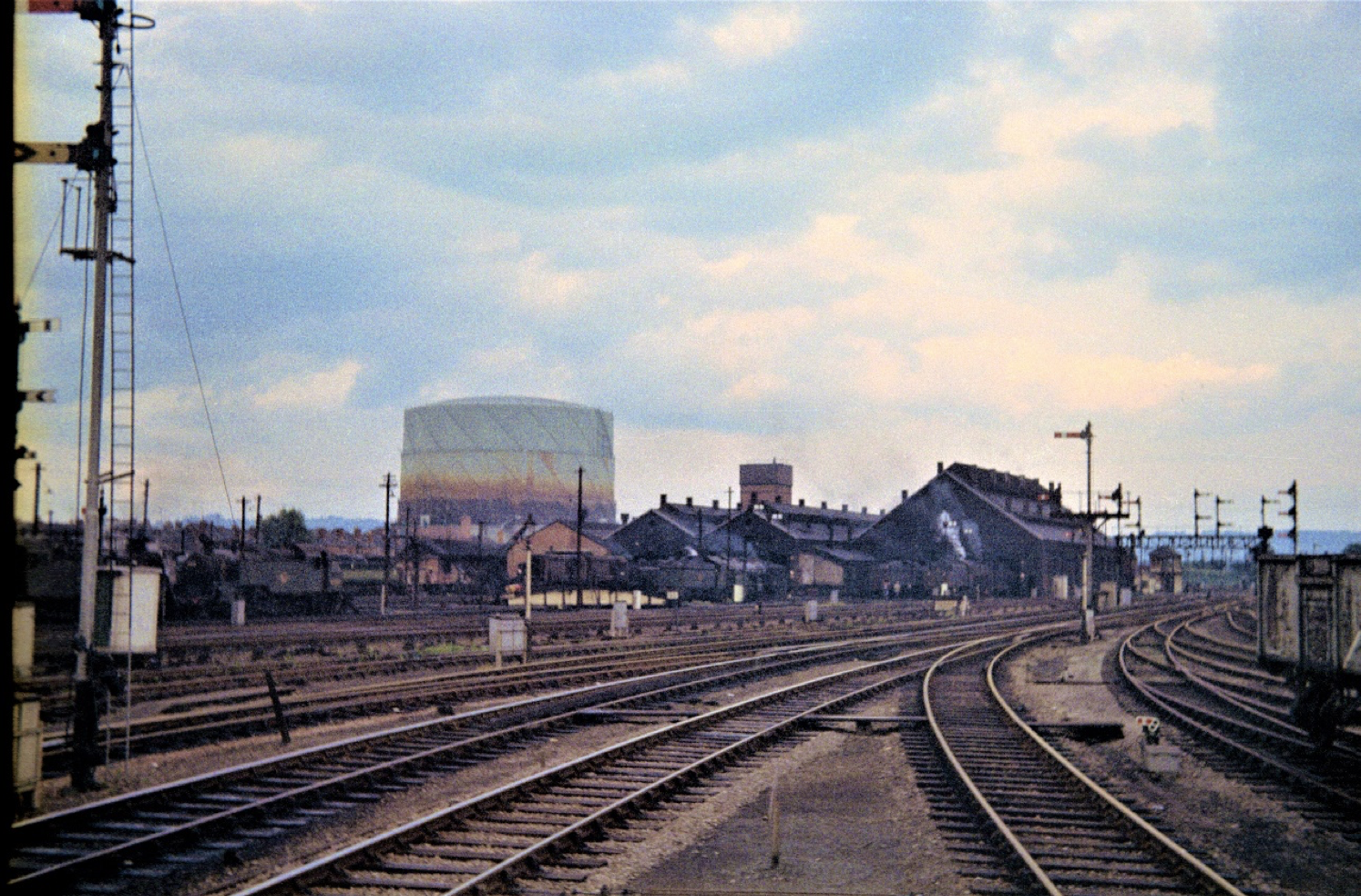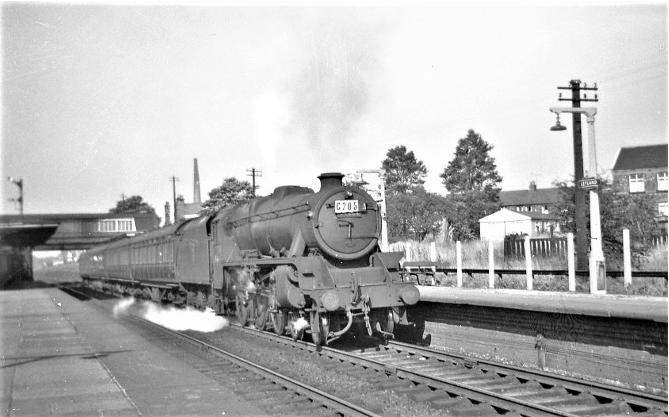Blackpool Illuminations by Steam: 1959 – 1962
“There’s a famous seaside place called Blackpool…”, or Gloucester to Blackpool illuminations by steam
(with apologies to Stanley Holloway)
It’s safe to say that there has always been an element of bi-partisanship amongst the railway fraternity in Gloucester, in terms of support for the Midland or Great Western Railways. Personally, I must admit to being a follower of the Midland camp, probably because my grandparents lived in Tredworth Road in a house south of Eastgate station close to a level crossing which the Midland euphemistically called Painswick Road Crossing, although native Gloucestrians always referred to it as ‘Tredworth Gates’. In fact, an examination of an early Ordnance Survey map shows that when the line was built, the area was in open country and the lane did eventually lead to Painswick. From the front-room window, a variety of steam locomotives could be spotted, and these sights provided the impetus to seek out grander engines that the ‘Jubilees’ which were the largest LMS locomotives officially allowed through Gloucester at that time.
For the teenage enthusiast still at school, just that opportunity was provided by the advent of cheap weekend excursions to Blackpool during the ‘illuminations’ season. In fact, as early as 1932 the LMS had placed advertisements in the local paper ‘The Citizen’ offering cheap trips to Blackpool Illuminations for 9/6d, although if you required lunch on the outward trip or supper on return you would pay 3/- for each meal and have a reserved seat. By 1959 the excursion fare was 40/-, but this was still good value as the problem of finding somewhere to sleep was avoided, both forward and return journeys being made overnight. Such trips enabled one to spend a whole Saturday exploring the intricacies of the Central and Western Divisions of the LMR in Lancashire. Moreover, in two successive years the routing devised for these excursions turned out to be so obtuse that the ghosts of timetable compilers from the pre-grouping era might well have had a hand in their planning.
1959
The first trip in 1959, with my friend Dave Keveren (who incidentally became a fireman at Barnwood MPD towards the end of steam), was the prelude to several trips to Blackpool, culminating in a final journey by service train in 1962. So late on 2 October 1959 we caught a Western Region train originating at Swindon that had run via the Stroud valley before reversing at Gloucester Central. To the best of my recollection, No. 5951 Clyffe Hall, a Gloucester engine, was the loco provided to take the train north. After a stop at Cheltenham Spa Lansdown, the train jogged up the Midland main line, but as soon as the opportunity arose, reverted to ex-GW metals at Abbotswood Junction. By the time we had reached Worcester Shrub Hill it was one o’clock in the morning, but we were wide awake at what was becoming quite an adventure! Our journey continued by the ‘Old Worse and Worse’ (Oxford Worcester & Wolverhampton Railway to historians), until we stopped again.
Gas lights on the platform sizzled and popped. Grimy brown enamel ‘sausage’ totems hung from the station awning just legible in the gloom – Stourbridge Junction. Steam from the carriage heating billowed up from under the bogies all but obscuring the view outside when combined with the condensation now running down the inside of our window. In the compartment the stale smell of damp steam from the heating ducts under the seats lingered. Nevertheless, there appeared to be some activity outside. A silhouette with the distinctive outline of a GW locomotive, the combined safety-valve and top-feed cover, ambled about inconsequentially in the shadows. Its grubby numberplate remained tantalisingly unreadable: why didn’t Western locos have nice large white numerals like every other region? And yet lurking here also, more surprisingly, was No. 49126, a ‘Duck-Eight’ (our name for the Super Ds) from Stafford MPD, presumably having arrived from the Bescot direction.
The purpose of the stop was to enable a pilot engine to be attached to assist the train engine up the 1 in 50 gradients into the Black Country. The firebox glow from the engines reflected back off the twin columns of smoke and steam as we forged our way up through picturesquely named Brettell Lane and Brierley Hill, competing with flares in the night sky as Round Oak steelworks continued to cast metal. We dived into a tunnel and stopped at Dudley, where the pilot was removed. The shadow of an unidentified large Prairie tank slipped back towards Stourbridge Junction. Our ‘Hall’ continued on through Priestfield, where the ‘new’ line from Birmingham curved in sharply from the right, to Wolverhampton (Low Level) for a crew change.
We were soon away again, galloping along for the first time: the effect of a new driver perhaps? We certainly left Shifnal shaking as we rattled through onto the Shropshire plain. But alas, this burst of speed was short-lived. After slowing to a snail’s pace, we dived off the main line to the right, and into what was, as far as I was concerned, terra incognita. So much for my musing that we might travel to Shrewsbury or even Chester by GWR.
What in fact we were doing was taking the ‘back door’ route via Market Drayton and Audlem to the LMS mecca, although I didn’t realise this until the towering searchlights of Crewe appeared in the distance. Our excursion train ground to a halt outside Gresty Lane MPD, where our ‘Hall’ was exchanged for an anonymous ‘Black Five’. Crewe was a hive of activity, even around three o’clock in the morning. We then slowly snaked our way through the goods lines to the back of the passenger station, past passenger locos lurking in the darkest recesses of Crewe South MPD, at last heading north past Coppenhall into the flat Cheshire countryside. We are riding up the West Coast Main Line through Hartford at a fairly brisk pace now, into the land of ‘Scots’ and ‘Semis’. Hartford was where my lucky companion went to visit relatives, and on his return he would rejoinder me with tales of Polmadie ‘Scots’ working down to Crewe and ‘Directors’ on the CLC line from Northwich.
The four-track section rises and falls over the Manchester Ship Canal, as impressive as any future motorway viaduct: its approaches guarded by twinkling flocks of tall upper-quadrant semaphores. We pass Warrington Bank Quay and its louring soap works; then coal heaps, and there’s a cacophony of sound as the carriage bogies rattle across the spaghetti-junction of tracks announcing the southern approach to Wigan. A final gallop down through Euxton Junction over the Ribble viaduct and we come to a rest in Preston.
Departing, the ‘Black Five’ struggles to keep its feet as it attacks the sharp climb out of the station – no thanks to the early morning dew on the railhead. Even in the early morning half-light the delicate Victorian Gothic spire of St. Walburge’s dominates the northern approaches as it does in so many railway photographs. We dawdle past Preston MPD on the left and continue along the four-track section to the Fylde coast, whilst the main line to the north slips off right under a road bridge, as if a branch. We are on the last lap now as a watery sun rises through the fog to enlighten Poulton-le-Fylde. We must be boxing the compass now as the sun appears first through one side and then the other side of the carriage: we are turning south-west now, and there is the Tower, straight ahead. Blackpool North. We stumble into the cold damp air and wander, bleary-eyed down the platform. A rather dirty 5A ‘Black Five’, No. 44762, stands in sizzling warmth at the head of the train whilst the coaldust-stained fireman, knotted handkerchief on his head, hangs over the cab-side, looking rather pleased with himself, as well he might.
Our aim that weekend was to combine our observation of ‘big’ West Coast steam with travelling around on the augmented passenger services of a more local nature generated by the ‘Illuminations’ season. So, after a cursory glance at the empty sea-front we walked to Blackpool’s Central station to travel back to Preston on the coast line through St Anne’s and Lytham. Here were 4-6-0s and 2-6-4Ts of various types from Blackpool, Lostock Hall and Newton Heath MPDs going about their daily business on locals and semi-fasts across the breadth of old Lancashire & Yorkshire Railway’s system, a network that had always fascinated me. Some of the larger engines from this part of the world would turn up in Gloucester occasionally, particularly during the ‘pigeon’ season in late spring, when north-country pigeon fanciers sent their racing pigeons from for example, Burnley or Accrington, twenty van-loads at a time, to be liberated by porters at Mangotsfield, or somewhere similar. Now they all go by road.
But at Preston the best sight, the one we had been waiting for, was the arrival of the morning train to Glasgow, behind an immaculate No. 46104 Scottish Borderer, sporting a front numberplate embellished in red by Polmadie’s shed staff. Here, at last, was one of those big Scottish locos, which somehow never seemed to penetrate south of Crewe – certainly we had never seen any on our occasional train-spotting sorties from Gloucester to the west coast main line at Tamworth. Due to the recent introduction of 2-car Derby and Metro-Cammell DMUs on some local services in the Preston area, we decided to take a short train ride to Leyland for the afternoon. The station was a grand place to see main-line steam in its element, with its four long platforms, one for each road, overlooked to the south by a pair of lanky double-semaphore signals with full-scale repeaters. They would have been visible from afar for crews of the Anglo-Scottish expresses as they swooped down from Euxton Junction, now halfway home to Glasgow.
With the Blackpool illuminations season in full flow, by late afternoon there was a steady procession of passenger trains, all sporting reporting numbers to ease the signalmen’s task. From Manchester, Yorkshire and the Midlands excursions formed of motley rakes of rolling-stock, some non-corridor, frequently with a ‘Black Five’ at the head, made their way towards Blackpool. Several ‘B1s’ also managed to escape from Yorkshire across the Pennines on illumination specials. The West Coast main line also produced some interesting sights. A ‘Jubilee’ in fine tune purred up the bank at the head of the afternoon train from Barrow to Euston. And much to our delight, for diesel locomotives were extremely interesting then, a brand-new Co-Co English Electric Type 4, No. D212, took the northbound ‘Midday Scot’. Finally, as we waited on the down relief platform to return to Preston came a truly memorable sight. One of Polmadie’s Clans, No. 72003 Clan Fraser came thundering south on what was probably the 12.20pm Perth to Euston express, throwing its grey exhaust high into a fine October evening’s sky.
One interesting sight on our return to Blackpool North was a solitary stationary boiler standing in the midst of rolling stock at the excursion platforms, which was reported to be the remains of an ex-L&Y ‘G2’ 0-4-4T, now relegated to carriage heating. Then it was just a question of queuing up in the vast concourse of Blackpool North to await the arrival of the stock for our return train.
Stanier Class 5 No. 45464 pulls away from a stop at Leyland at the head of C205, a Blackpool to Manchester Victoria semi-fast on 2 October 1959.

